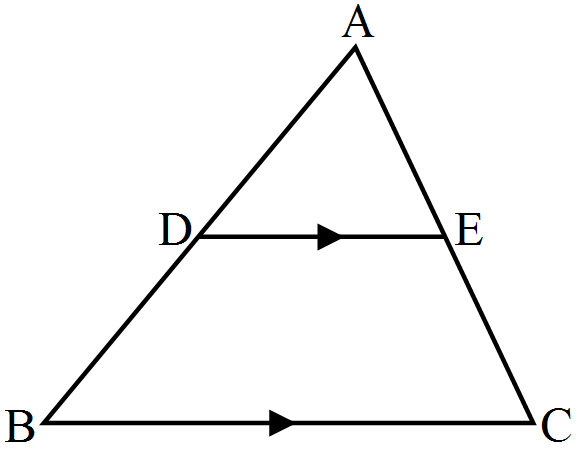90649
DIRECTION: In the following questions, a statement of assertion (A) is followed by a statement of reason (R). Mark the correct choice as:
Assertion: D and E are points on the sides AB and AC respectively of a \( \triangle\text{ABC} \) such that AB = 10.8cm, AD = 6.3cm, AC = 9.6cm and EC = 4cm then DEis parallel to BC.
Reason: If a line is parallel to one side of a triangle then it divides the other two sides in the same ratio.
90653
DIRECTION: In the following questions, a statement of assertion (A) is followed by a statement of reason (R). Mark the correct choice as:
Assertion: D and E are points on the sides AB and AC respectively of a \( \triangle\text{ABC} \) such that DE || BCthen the value of x is 4, when AD = x cm, DB = (x - 2)cm, AE = (x + 2) cm and EC = (x - 1)cm.
Reason: If a line is parallel to one side of a triangle then it divides the other two sides in the same ratio.
90649
DIRECTION: In the following questions, a statement of assertion (A) is followed by a statement of reason (R). Mark the correct choice as:
Assertion: D and E are points on the sides AB and AC respectively of a \( \triangle\text{ABC} \) such that AB = 10.8cm, AD = 6.3cm, AC = 9.6cm and EC = 4cm then DEis parallel to BC.
Reason: If a line is parallel to one side of a triangle then it divides the other two sides in the same ratio.
90653
DIRECTION: In the following questions, a statement of assertion (A) is followed by a statement of reason (R). Mark the correct choice as:
Assertion: D and E are points on the sides AB and AC respectively of a \( \triangle\text{ABC} \) such that DE || BCthen the value of x is 4, when AD = x cm, DB = (x - 2)cm, AE = (x + 2) cm and EC = (x - 1)cm.
Reason: If a line is parallel to one side of a triangle then it divides the other two sides in the same ratio.
90649
DIRECTION: In the following questions, a statement of assertion (A) is followed by a statement of reason (R). Mark the correct choice as:
Assertion: D and E are points on the sides AB and AC respectively of a \( \triangle\text{ABC} \) such that AB = 10.8cm, AD = 6.3cm, AC = 9.6cm and EC = 4cm then DEis parallel to BC.
Reason: If a line is parallel to one side of a triangle then it divides the other two sides in the same ratio.
90653
DIRECTION: In the following questions, a statement of assertion (A) is followed by a statement of reason (R). Mark the correct choice as:
Assertion: D and E are points on the sides AB and AC respectively of a \( \triangle\text{ABC} \) such that DE || BCthen the value of x is 4, when AD = x cm, DB = (x - 2)cm, AE = (x + 2) cm and EC = (x - 1)cm.
Reason: If a line is parallel to one side of a triangle then it divides the other two sides in the same ratio.
90649
DIRECTION: In the following questions, a statement of assertion (A) is followed by a statement of reason (R). Mark the correct choice as:
Assertion: D and E are points on the sides AB and AC respectively of a \( \triangle\text{ABC} \) such that AB = 10.8cm, AD = 6.3cm, AC = 9.6cm and EC = 4cm then DEis parallel to BC.
Reason: If a line is parallel to one side of a triangle then it divides the other two sides in the same ratio.
90653
DIRECTION: In the following questions, a statement of assertion (A) is followed by a statement of reason (R). Mark the correct choice as:
Assertion: D and E are points on the sides AB and AC respectively of a \( \triangle\text{ABC} \) such that DE || BCthen the value of x is 4, when AD = x cm, DB = (x - 2)cm, AE = (x + 2) cm and EC = (x - 1)cm.
Reason: If a line is parallel to one side of a triangle then it divides the other two sides in the same ratio.
90649
DIRECTION: In the following questions, a statement of assertion (A) is followed by a statement of reason (R). Mark the correct choice as:
Assertion: D and E are points on the sides AB and AC respectively of a \( \triangle\text{ABC} \) such that AB = 10.8cm, AD = 6.3cm, AC = 9.6cm and EC = 4cm then DEis parallel to BC.
Reason: If a line is parallel to one side of a triangle then it divides the other two sides in the same ratio.
90653
DIRECTION: In the following questions, a statement of assertion (A) is followed by a statement of reason (R). Mark the correct choice as:
Assertion: D and E are points on the sides AB and AC respectively of a \( \triangle\text{ABC} \) such that DE || BCthen the value of x is 4, when AD = x cm, DB = (x - 2)cm, AE = (x + 2) cm and EC = (x - 1)cm.
Reason: If a line is parallel to one side of a triangle then it divides the other two sides in the same ratio.
.jpg)

